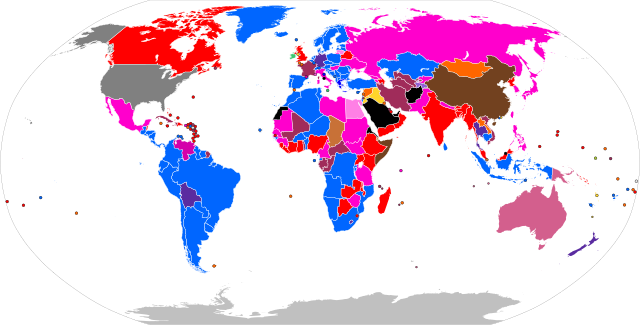Party-list proportional representation (list-PR) is a system of proportional representation based on preregistered political parties, with each party being allocated a certain number of seats roughly proportional to their share of the vote.[1]

In these systems, parties provide lists of candidates to be elected, or candidates may declare their affiliation with a political party (in some open-list systems). Seats are distributed by election authorities to each party, in proportion to the number of votes the party receives. Voters may cast votes for parties, as in Spain, Turkey, and Israel (closed lists); or for candidates whose vote totals are pooled together to parties, as in Finland, Brazil, and the Netherlands (mixed single vote or panachage).[2][3]
Voting
In most party list systems, a voter will only support one party (a choose-one ballot). Open list systems may allow voters to support more than one candidate within a party list. Some open-list systems allow voters to support different candidates across multiple lists, which is called panachage.
Selection of party candidates
The order in which a party's list candidates get elected may be pre-determined by some method internal to the party or the candidates (a closed list system) or it may be determined by the voters at large (an open list system) or by districts (a local list system).
Closed list
In a closed list system, each political party has pre-decided who will receive the seats allocated to that party in the elections, so that the candidates positioned highest on this list will always get a seat in the parliament while the candidates positioned very low on the closed list will not. Voters vote only for the party, not for individual candidates.
Open list
An open list describes any variant of a party-list where voters have at least some influence on the order in which a party's candidates are elected. Open lists can be anywhere from relatively closed, where a candidate can move up a predetermined list only with a certain number of votes, to completely open, where the order of the list completely depends on the number of votes each individual candidate gets.[4]
Apportionment of party seats
Many variations on seat allocation within party-list proportional representation exist. Different apportionment methods may favor smaller or larger parties:[5]
- D'Hondt method (biased towards large parties)[6]
- Sainte-Laguë method (roughly unbiased)
- Huntington–Hill method (roughly unbiased)
- Adams method (biased towards small parties)
- LR-Hare (roughly unbiased)
- LR-Droop (biased towards large parties)
The apportionment methods can be classified into two categories:
- The highest averages method (or divisor method), including the D'Hondt method (Jefferson method) is used in Armenia, Austria, Brazil, Bulgaria, Cambodia, Croatia, Estonia, Finland, Poland, and Spain; and the Sainte-Laguë method (Webster method) is used in Indonesia, New Zealand, Norway, and Sweden.
- The largest remainder (LR) methods, including the Hamilton (Hare) method and Droop method.
While the allocation formula is important, equally important is the district magnitude (number of seats in a constituency). The higher the district magnitude, the more proportional an electoral system becomes, with the most proportional results being when there is no division into constituencies at all and the entire country is treated as a single constituency.[citation needed] In some countries the electoral system works on two levels: at-large for parties, and in constituencies for candidates, with local party-lists seen as fractions of general, national lists. In this case, magnitude of local constituencies is irrelevant, seat apportionment being calculated at national level.
List proportional representation may also be combined with other apportionment methods in various mixed systems, using either additional member systems or parallel voting.
Example
Below it can be seen how different apportionment methods yield different results when apportioning 100 seats. Here, parties B and A are
Webster's method yields the same result (though this is not always the case). Otherwise, all other methods give a different number of seats to the parties.
Notice how the D'Hondt method breaks the quota rule (shown in red text) and favors the largest party by "rounding" an ideal apportionment of 35.91 up to 37.
Adams' method greatly favor smaller parties, giving 2 seats to the smallest party, and would give at least 1 seat to every party receiving at least one vote.
| Party | Votes | Entitlement | Largest remainders | Highest averages | ||||
|---|---|---|---|---|---|---|---|---|
| Hare | Droop quota | D'Hondt (Jefferson) | Sainte-Laguë (Webster) | Huntington-Hill | Adams | |||
| A | 1017 | 35.91 | 36 | 36 | 37 | 36 | 36 | 35 |
| B | 1000 | 35.31 | 35 | 36 | 36 | 35 | 35 | 34 |
| C | 383 | 13.52 | 14 | 13 | 13 | 14 | 13 | 14 |
| D | 327 | 11.55 | 12 | 12 | 11 | 12 | 12 | 12 |
| E | 63 | 2.22 | 2 | 2 | 2 | 2 | 2 | 3 |
| F | 42 | 1.48 | 1 | 1 | 1 | 1 | 2 | 2 |
| Total | 2832 | 100 seats | 100 | 100 | 100 | 100 | 100 | 100 |
Electoral threshold
List of countries using party-list proportional representation

The table below lists countries that use a proportional electoral system to fill a nationally elected legislative body. Detailed information on electoral systems applying to the first chamber of the legislature is maintained by the ACE Electoral Knowledge Network.[7][8] Countries using PR as part of a parallel voting (mixed-member majoritarian) or other mixed system (e.g. MMP) are not included.
Authoritarian regimes
| Country | Legislative body | List type | Apportionment method | Electoral threshold | Constituencies | Governmental system | Notes |
|---|---|---|---|---|---|---|---|
| Burkina Faso | National Assembly | Closed list | Constituencies | Semi-presidential republic | |||
| Burundi | National Assembly | Closed list | D'Hondt method | 2% | Constituencies | Presidential republic | |
| Cambodia | National Assembly | Closed list | D'Hondt method | Constituencies | Constitutional monarchy | ||
| Equatorial Guinea | Chamber of Deputies | Closed list | 10% | Constituencies | Presidential republic | ||
| Senate | Closed list | Constituencies | |||||
| Guinea-Bissau | National People's Assembly | Closed list | Semi-presidential republic | ||||
| Mozambique | Closed list | ||||||
| Rwanda | Closed list | ||||||
| Togo | National Assembly | Closed list | Highest averages method | No threshold | Constituencies | Presidential system |
See also
- Comparison of the Hare and Droop quotas
- General ticket (party block voting), a term usually given to less or non proportional equivalents
- Mixed-member proportional representation, a kind of party-list proportional representation
- Leveling seats
- List MP
- Ley de Lemas
- Sectoral representation in the House of Representatives of the Philippines
- Outline of democracy
References
External links
Wikiwand in your browser!
Seamless Wikipedia browsing. On steroids.
Every time you click a link to Wikipedia, Wiktionary or Wikiquote in your browser's search results, it will show the modern Wikiwand interface.
Wikiwand extension is a five stars, simple, with minimum permission required to keep your browsing private, safe and transparent.
 ,
,  ...
...

